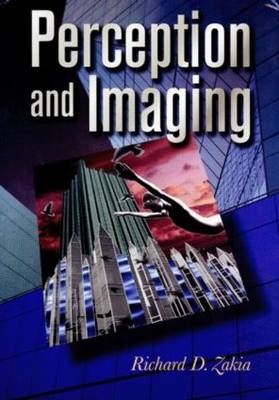
Perception and Imaging
Focal Press (Verlag)
978-0-240-80201-5 (ISBN)
- Titel erscheint in neuer Auflage
- Artikel merken
All those who work with images will find this introduction to the principles of visual perception invaluable. The text covers memory and association: space, time, color, contours, illusions, ambiguity, and personality factors. Dr. Zakia incorporates ideas and principles from a variety of disciplines that are highly relevant to photography and imaging, and shows how they can be applied for greatest artistic effect. The text itself is highly visual with over 250 illustrations from disparate media, including the works of such photographers as Edward Weston, Henri Cartier-Bresson, August Sander, and Barbara Morgan, as well as digital images and popular advertisements.
Dr. Zakia demonstrates how the eye organizes information through a wide variety of images including: photographs, paintings, sculptures, moving images, video, animation, digital imaging, computer displays, and multimedia. With an up-to-date discussion of such topics as subliminals and morphics, anyone creating visual images will benefit from this approach to perception. Each chapter concludes with a series of hands-on exercises. Although addressed to photographers and graphic designers, Perception and Imaging is intended for anyone seriously concerned in the shaping or making of visual messages and visual environments. All have a common purpose- visual communication and expression.
Richard Zakia is a 1956 graduate of the Rochester Institute of Technology (RIT). Some of his classmates at the time were Carl Chiarenza, Peter Bunnell, Bruce Davidson, Ken Josephson, Pete Turner and Jerry Uelsmann. Minor White was a member of the faculty and Beaumont Newhall was Adjunct. It was a great and enriching mix. After graduation he was employed as a photographic engineer in the Color Technology Division of Eastman Kodak. During the Sputnik era he decided teaching was his vocation and accepted a position with RIT where he served for 34 years. For a time he was Director of Instructional Research and Development and Chair of the Fine Art Photography Department and graduate program in Imaging Arts. He is a recipient of the Eisenhart Outstanding Teaching Award. Zakia has authored and co-authored thirteen books on photography and perception. He is also the co-editor with Dr. Leslie Stroebel of the third edition (1993) of The Focal Encyclopedia of Photography and a contributor to the fourth edition (2007). His most recent book is Teaching Photography with Dr. Glen Rand. Richard Zakia is a 1956 graduate of the Rochester Institute of Technology (RIT). Some of his classmates at the time were Carl Chiarenza, Peter Bunnell, Bruce Davidson, Ken Josephson, Pete Turner and Jerry Uelsmann. Minor White was a member of the faculty and Beaumont Newhall was Adjunct. It was a great and enriching mix. After graduation he was employed as a photographic engineer in the Color Technology Division of Eastman Kodak. During the Sputnik era he decided teaching was his vocation and accepted a position with RIT where he served for 34 years. For a time he was Director of Instructional Research and Development and Chair of the Fine Art Photography Department and graduate program in Imaging Arts. He is a recipient of the Eisenhart Outstanding Teaching Award. Zakia has authored and co-authored thirteen books on photography and perception. He is also the co-editor with Dr. Leslie Stroebel of the third edition (1993) of The Focal Encyclopedia of Photography and a contributor to the fourth edition (2007). His most recent book is Teaching Photography with Dr. Glen Rand.
Selection: Ganzfeld, Figure-Ground, Notan, Visual Search, Camoflage; Gestalt Grouping: Field Theory, Gestalt, Proximity, Similarity, Continuity, Closure, Zeingarnik Effect, Gestalt Critique, Pragnanz, Seeing, Order and Complexity, Information Theory, Gestalt Summary, Graphic Summary; Memory and Association: Short-term Memory, Long-term Memory, Visual Memory, Color Memory, Association, Equivalents, Sysesthesia; Space, Time, Color: Space, Anistropic, Convexity and Concavity, Transparency, Time (Movement), Implied Motion, Disappearence, Color, Simultaneous Contrast, Assimilation, Color Modality; Contours: Common Contour, Subjective Contour, Mach Bands, Visual Vibrations; Illusions and Ambiguity: Tromp l'Oeil, Geometric Illusions, Reversibles, Movements Illusions, Pulfrich Effect, Waterfall Effect, Color Illusions, Size-Distance Tradeoffs, Dutch Cabinets, Size-Size Dependency, Emmert's Law, Ambiguity; The Morphics: Isomorphics, Anthropomorphics, Zoomorphic, Theriomorphic, Mechanomorphic, Anamorphic, Polymorphic, Amorphic; Personality: Projection, Introjection, Confluence, Personality Types, Right and Left Brain, Personal Space, Field Dependency, Leveling and Sharpening; Subliminals: The Retina, Embeds, Secondary Images, Faces, Pupillometrics, Archetypes, Kilroy; Critiquing Photographs: Critique as Evaluation, Validity, Variability, Photographer's Comments, Critiquing, Clustering, Semantic Differential, Critiquing Without Words, Rhetoric; Glossary; Notes; Bibliography; Appendix; Index.
| Erscheint lt. Verlag | 28.2.1997 |
|---|---|
| Verlagsort | Oxford |
| Sprache | englisch |
| Themenwelt | Kunst / Musik / Theater ► Fotokunst |
| Geisteswissenschaften ► Psychologie ► Allgemeine Psychologie | |
| Geisteswissenschaften ► Psychologie ► Biopsychologie / Neurowissenschaften | |
| Geisteswissenschaften ► Psychologie ► Verhaltenstherapie | |
| ISBN-10 | 0-240-80201-2 / 0240802012 |
| ISBN-13 | 978-0-240-80201-5 / 9780240802015 |
| Zustand | Neuware |
| Haben Sie eine Frage zum Produkt? |
aus dem Bereich



